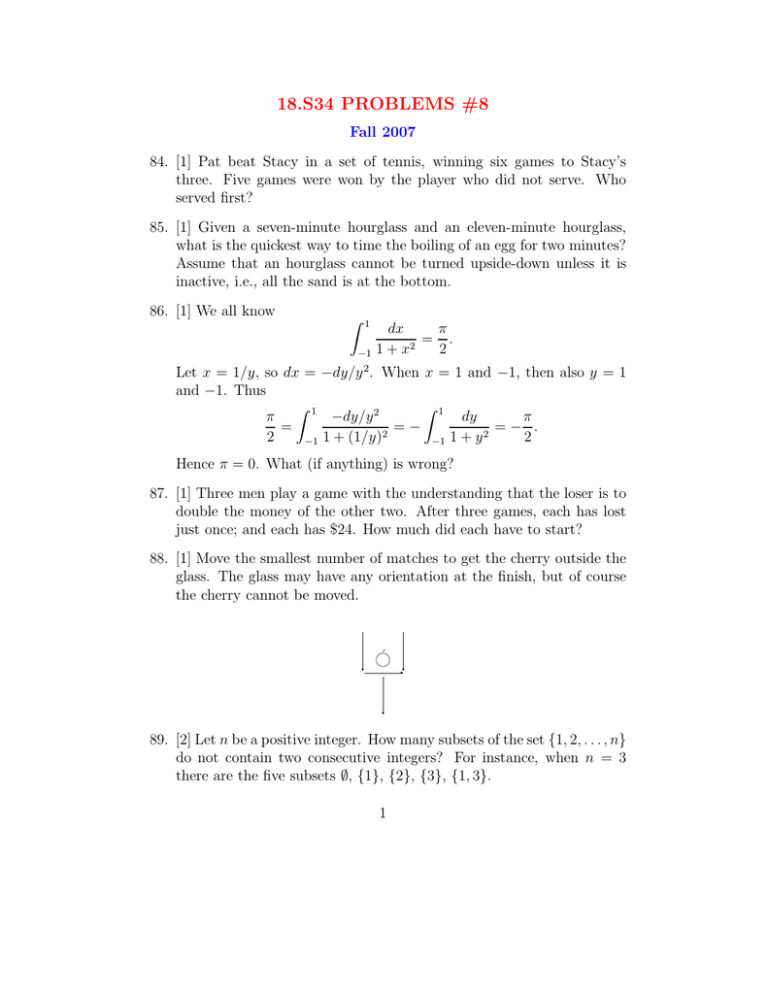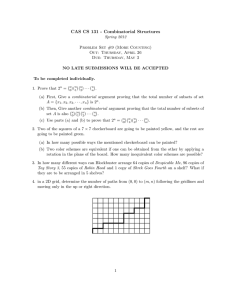18.S34 PROBLEMS #8
advertisement

18.S34 PROBLEMS #8
Fall 2007
84. [1] Pat beat Stacy in a set of tennis, winning six games to Stacy’s
three. Five games were won by the player who did not serve. Who
served first?
85. [1] Given a seven-minute hourglass and an eleven-minute hourglass,
what is the quickest way to time the boiling of an egg for two minutes?
Assume that an hourglass cannot be turned upside-down unless it is
inactive, i.e., all the sand is at the bottom.
86. [1] We all know
�
1
−1
2
dx
�
= .
2
1+x
2
Let x = 1/y, so dx = −dy/y . When x = 1 and −1, then also y = 1
and −1. Thus
� 1
� 1
−dy/y 2
dy
�
�
=
=
−
=
−
.
2
2
2
2
−1 1 + (1/y)
−1 1 + y
Hence � = 0. What (if anything) is wrong?
87. [1] Three men play a game with the understanding that the loser is to
double the money of the other two. After three games, each has lost
just once; and each has $24. How much did each have to start?
88. [1] Move the smallest number of matches to get the cherry outside the
glass. The glass may have any orientation at the finish, but of course
the cherry cannot be moved.
89. [2] Let n be a positive integer. How many subsets of the set {1, 2, . . . , n}
do not contain two consecutive integers? For instance, when n = 3
there are the five subsets �, {1}, {2}, {3}, {1, 3}.
1
90. [2] What positive integers can be expressed as the difference between
two squares? The first six are 1 = 12 − 02 , 3 = 22 − 12 , 4 = 22 − 02 ,
5 = 3 2 − 22 , 7 = 4 2 − 32 , 8 = 3 2 − 12 .
91. [2] In a room 30 feet long, 12 feet wide, and 12 feet high, a fly stands
on an end wall one foot above the floor and 6 feet from each side wall.
A spider stands on the opposite end wall one foor below the ceiling and
6 feet from each side wall. What is the minimum distance the spider
needs to walk along the walls, floor, and ceiling in order to reach the
fly?
�6
�
�
�
�
�
1�6
spider
�
fly
12
�
6��1
6�
�
12 �
�
30
92. [2.5] Can an obtuse triangle be dissected into acute triangles?
93. [2.5] Two baseball teams A and B play against each other for the
first time. All that is known about the teams is that A has won a
fraction p of its games and that B has won a fraction q, playing against
comparable opponents. What is the most reasonable probability f (p, q)
that A will beat B? For instance, a little thought will convince you
that f (p, 1/2) = p, f (p, 1) = 0 if p =
� 1, f (p, q) + f (q, p) = 1, etc. But
it’s not so obvious, for instance, what f (.7, .4) should be.
94. [2.5] n coins are placed in a circle, either heads or tails up. Player A
wants to turn all the coins heads up but is never aware of the status
of the coins. When it is his turn, he can specify any subset of the n
positions occupied by the coins. Player B can then rotate the coins
around the circle as many spaces as she wants. She then turns over all
the coins in the positions specified by A. For what values of n can A
win, i.e., in a finite amount of time guarantee that all coins are heads?
For instance, A can win when n = 2, by first choosing positions {1, 2},
2
then {1}, and then {1, 2}. It is easy to check that no matter what
the initial configuration of the coins, at some stage both coins will be
heads.
95. [2.5] Let R be a noncommutative ring with identity. Suppose that x, y
are elements of R such that 1 − xy and 1 − yx are invertible. Show that
(1 + x)(1 − yx)−1 (1 + y) = (1 + y)(1 − xy)−1 (1 + x).
(1)
This problem illustrates that “noncommutative high school algebra” is
a lot harder than ordinary (commutative) high school algebra.
Note. Formally we have
(1 − yx)−1 = 1 + yx + yxyx + yxyxyx + · · ·
and similarly for (1 − xy)−1 . Thus both sides of (1) are formally equal
to the sum of all “alternating words” (products of x’s and y’s with no
two x’s or y’s appearing consecutively). This makes the identity (1)
plausible, but our formal argument is not a proof.
3


